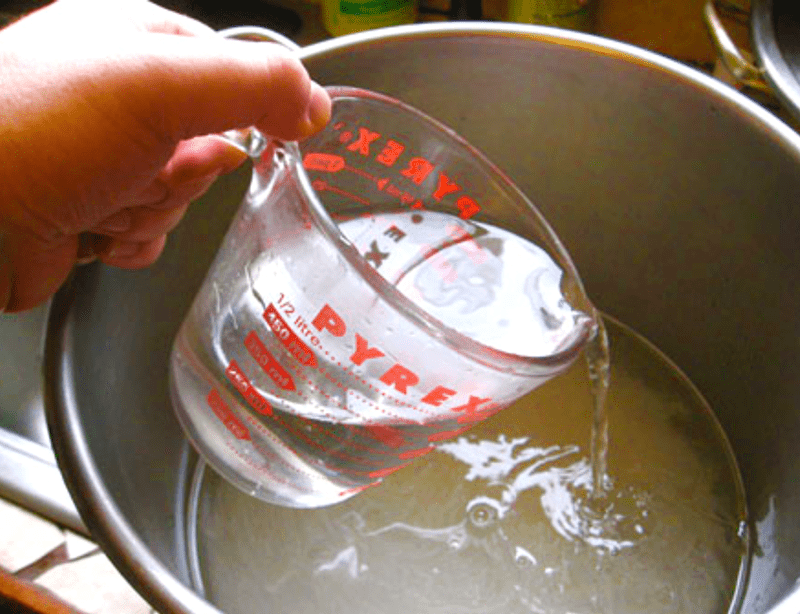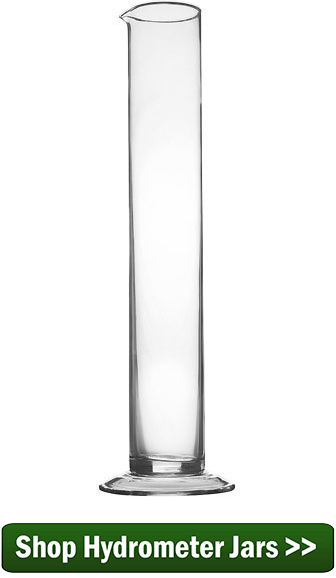 I have a question! After making a sugar-syrup, how much of it do I use to raise 5 gallons of wine? I mean how much does the S.G. [Specific Gravity, hydrometer reading] go up say per cup added? Thanks for any help.
I have a question! After making a sugar-syrup, how much of it do I use to raise 5 gallons of wine? I mean how much does the S.G. [Specific Gravity, hydrometer reading] go up say per cup added? Thanks for any help.
Name: Thomas R.
State: New York (Long Island)
—–
Hello Thomas,
Raising the specific gravity of a wine with sugar syrup is perfectly fine. It’s a great way to get the S.G. up to where you need it to be when making a fruit wine or even a grape wine the just needs a little boost.
Knowing how much sugar syrup add to the wine to get from point A to point B on a hydrometer scale would be great to know ahead of time, but to do this you need to know the specific gravity of the sugar syrup. Not a sugar syrups are the same.
You can use a wine hydrometer to determine the specific gravity of the sugar syrup you’ve made. Just put the hydrometer in a sample of the syrup, just like you would when testing your wine. If the reading goes off the scale, you can still get a reading. Just add an equal amounts of water and sugar syrup in a sample. Then take a gravity reading and times it by two.
As an example, let’s say after you added equal parts of water and sugar syrup, you get a reading of 1.150. That would mean that the sugar syrup’s “actual” S.G. is 1.300. You double the “gravity” part of your reading, because you cut the sugar syrup by half.
Once you know the S.G. of the sugar syrup, raising the specific gravity of your wine with sugar syrup is easy. It’s all just math.
Let’s say you want to add 6 ounce of sugar syrup that has an specific gravity of 1.300 to a gallon of wine:
A gallon of wine has 128 fluid ounces in it. You want to add 6 more fluid ounces of sugar syrup for a new total of 134 ounces. Now you need to spread the gravity of (300 times 6) over the 134 ounces (128 + 6). So it is (300 X 6) divided by 134. That equals 13.44. Let me shorten it up:
(Gravity of Syrup * Ounces of Syrup Per Gallon)/(128 + Ounces of Syrup Per Gallon) = Rise in S.G.
or
(300 * 6)/(128 + 6) = 13.44
What this means is that if you are raising the specific gravity of a wine with a sugar syrup that has a specific gravity reading of 1.300, and you add 6 fluid ounces of that syrup to each gallon of homemade wine, then the specific gravity of that homemade wine would be raised by 13.44 points on the gravity scale. For example, if the wine has a specific gravity of 1.060, the new reading would be 1.07344. You could round it to 1.073.
Hope this helps you out. Just plug the numbers into the equation as needed and you’ll know ahead the results with raising the specific gravity of a wine with sugar syrup.
There is also another blog post that is somewhat related to this subject that I’d thought you might be interested in: “Controlling Your Wine’s Alcohol“.
Happy Winemaking,
Ed Kraus
—–
Ed Kraus is a 3rd generation home brewer/winemaker and has been an owner of E. C. Kraus since 1999. He has been helping individuals make better wine and beer for over 25 years.

I recently made 5 gallons of peach wine from a kit. Following instructions, the SG levels were well within the recommended points. One of the last steps was to add the peach syrup-like additive. The instructions did not include checking the SG after adding the fruit bag, but I was curious and took a sample. It was extremely high. What did this step do to the actual alcohol content of the wine.
Steve, I do not know what type of kit you are making but that sounds like a flavor/sweetening pack. Before you added it to the wine the directions should have instructed you to add a packet of potassium sorbate which is a stabilizer to prevent the wine from fermenting the sugar that was just introduced to the wine. What this means is that the addition of the additive will do nothing to change the alcohol content as long as potassium sorbate was added. It is simply for flavor and sweetness.
Surprised your response did not use “Pearson’s Square”, which needs:
(A=S.G. of wine)
(B=S.G. of SS)
(C=S.G. desired)
I imagine your directions on using “Pearson’s Square” would be clearer than mine.
I use “Pearson’s Square for adjusting: S.G. alcohol content, and/or T.A.
Hi Ed,
I have been reading your Q&A blogs for some time and have always found them interesting and helpful. With regard to making wine adjustments, I have been using the online tools at WineAdds.com. Plug in a couple numbers and the program instantly calculates your adjustment needs for numerous fine-tuning agents. They also provided advice for each adjustment, such as, “Why adjust Brix?” for example. I routinely use their Brix/SG and RS adjustment calculators, have checked the desired end results with a hydrometer, and have found very good accuracy. Understanding the math behind an adjustment is essential to great wine making and having a trusty “plug-in” calculator can be helpful when you’re under the gun to make a quick adjustment.
I think this approach is incorrect, because it doesn’t consider the gravity of the juice, but only the gravity of the syrup. For instance, if the syrup has the same initial gravity as the juice, the final gravity after mixing them will not increase.
I think the right approach is to use a weighted average of the gravities. Based on the volumes from the example, the formula would be:
((SG_syrup*6)+(SG_juice*128))/(134)
Pretty sure that it was this site that provided the following notes. I’ve found it to be pretty accurate but I always use my hydrometer to check:
One pound of cane sugar will raise the potential alcohol of 5 gallons of wine must by 1%. If you are getting ready to ferment 5 gallons of wine must, and it has a potential alcohol of 9%, just add 3 pounds of cane sugar to get it to 12%.
2 cups of cane sugar equals 1 pound. If you don’t have a scale you can weigh your cane sugar by the cup.